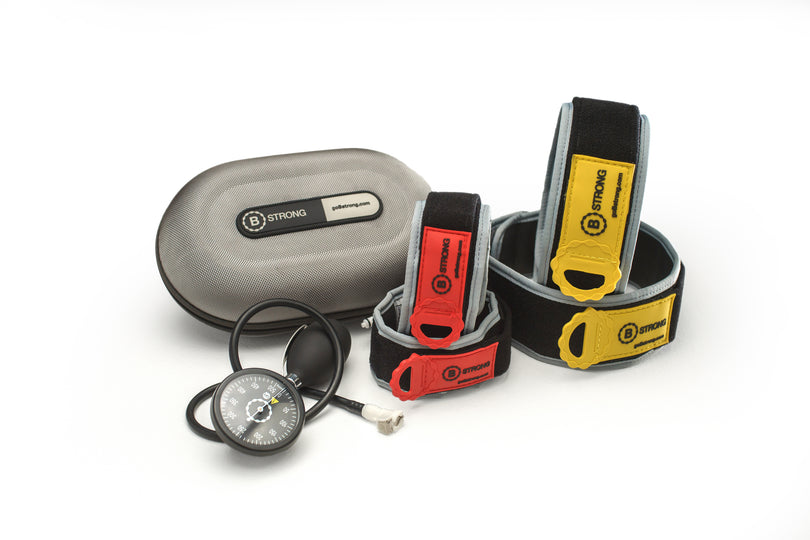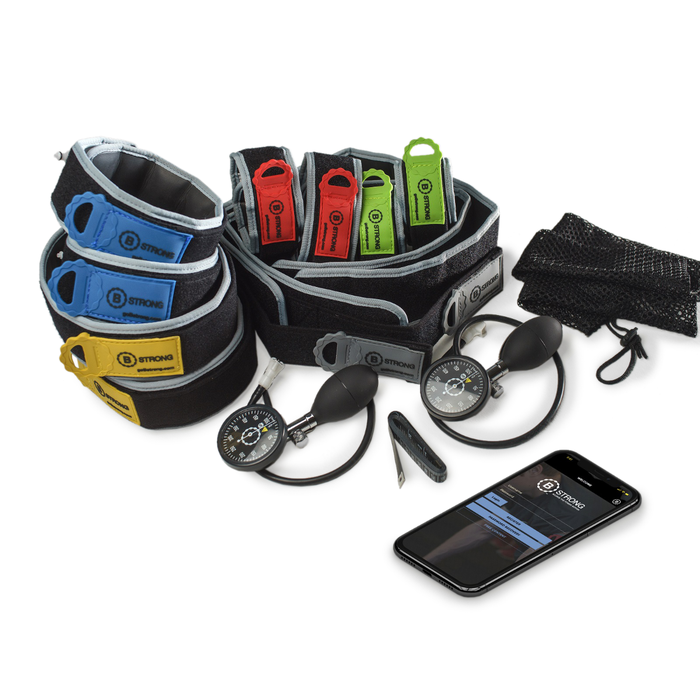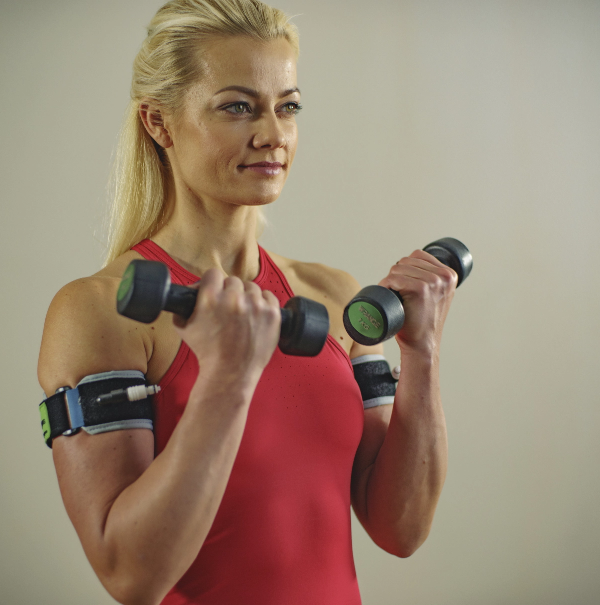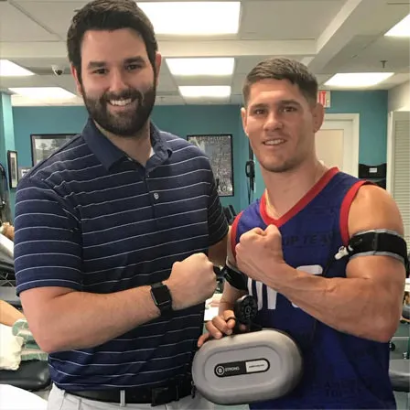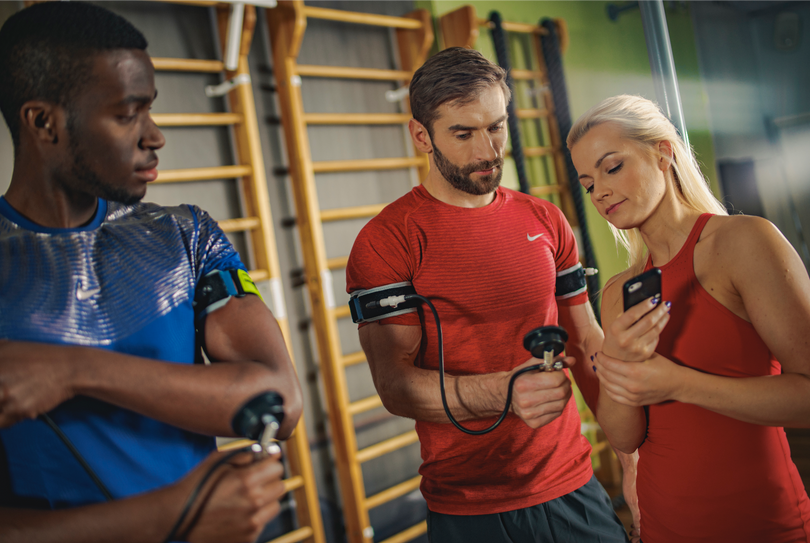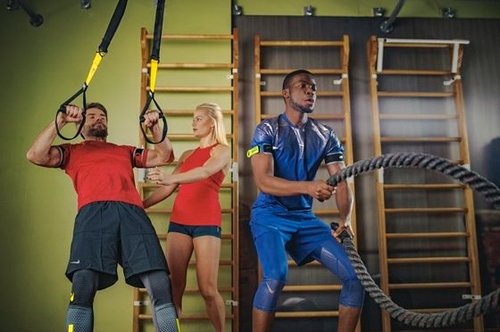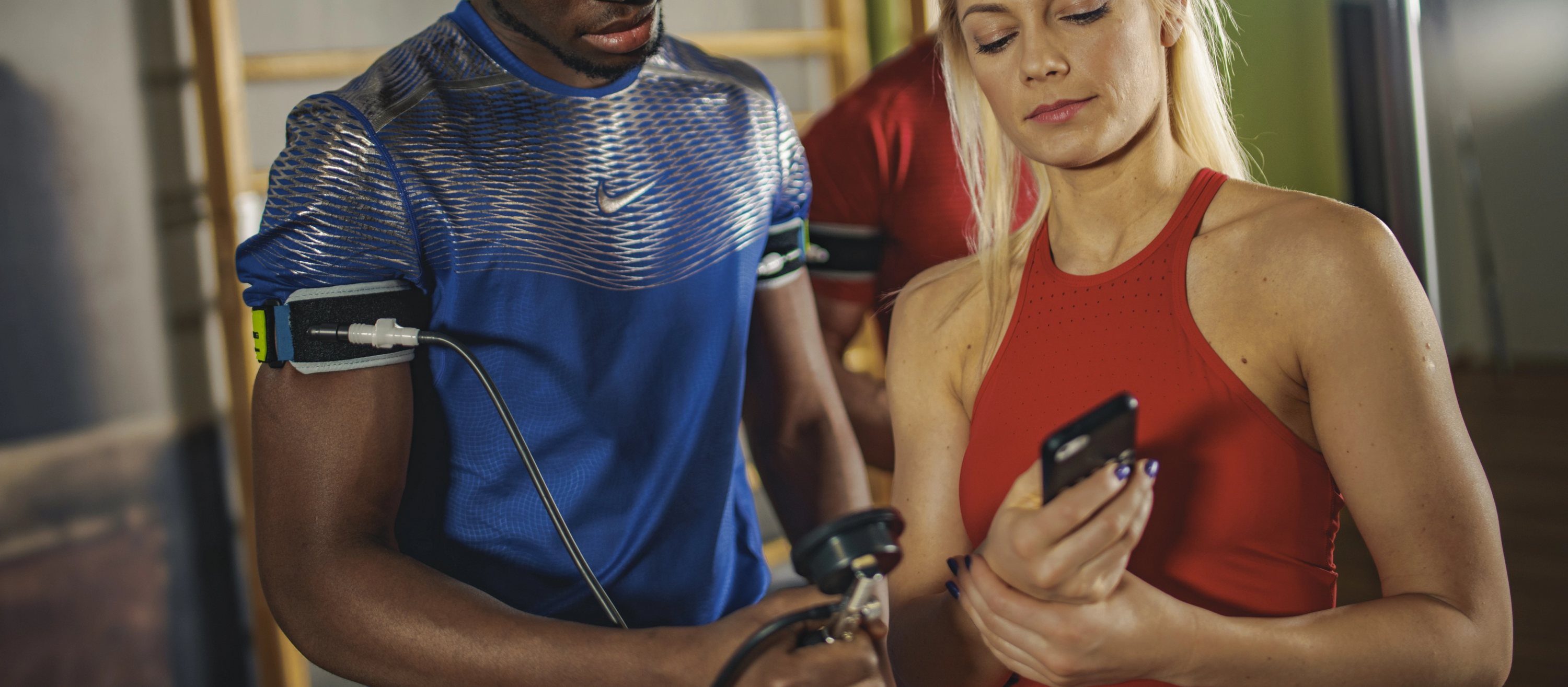Check out this recent podcast episode from Kathy Smith that goes over why BFR (blood flow restriction) training is truly the future of fitness. She interviews leading BFR expert Dr Jim Stray-Gundersen about its benefits and history. BFR helps improve muscle activation, increase strength while using lighter weights, recover more quickly from injuries, and reduce atrophy and loss of muscle mass as you age or from disuse.
Blood Flow Restriction uses cuffs placed around the uppermost portion of the arms and legs to maintain arterial inflow to the muscle while restricting venous return. The idea is that by restricting blood flow (not occluding or preventing) you trick the body into thinking it is working harder than it is and that produces some pretty amazing results.
There’s a lot of research that supports the method, which is why Blood Flow Restriction or BFR is becoming more popular with athletes, physical therapists, trainers and even celebrities like Mark Wahlberg.
Kathy has been training with BFR for months, using B-Strong bands. Check out more of the benefits of blood flow restriction training HERE
View the complete audio recording of the podcast on Kathy's website.
TRANSCRIPT:
Kathy Smith: Jim, welcome to the show.
Jim Stray-Gundersen: Thanks very much, Kathy. It’s a great pleasure to be here.
Kathy Smith: As I go through and see everything you’ve done, being a training geek, I love following your career. Why don’t you just take a second to talk about why, when you were younger, what drew you to this idea of focusing on human performance and sports training?
Jim Stray-Gundersen: Well…
Kathy Smith: Is that too long of a story?
Jim Stray-Gundersen: I’m not sure. But basically, while I was growing up and in my education process, academics and sport were very separate. While I was involved in sciences and my major – undergrad was zoology – and sports were always kind of secondary. I remember my mother saying to me I can’t go do those things unless my homework’s done.
As progressed through my academic career, I found an opportunity to go back to what I was passionate about, which is athletics. And in my case, it really started with endurance athletics. So things like middle and long-distance running, cross-country ski racing, speed skating, swimming, cycling, rowing, a variety of sports like that. I tried these, and I was not good enough to make it at an international level. But it turned out that I had something to offer for those people who were on the national teams.
So it’s just kind of more my academic career kind of morphed into being a doctor and physiologist and sometimes bus driver for a variety of athletes in a variety of sports. That’s really how we ended up where we are.
Kathy Smith: Interesting. So let’s jump into this blood flow restriction. I’ve heard you talk about it. I’ve gone to some of your workshops. And what I find fascinating is where it all started. Can you take us back to sort of the beginning and talk about how it started and where we’re at now with blood flow restriction?
Jim Stray-Gundersen: Yeah. I’d be happy to. Really, that first epiphany happened in about 1966 to Yoshiaki Sato who was an 18-year-old bodybuilder in Japan. And he had to go through a Japanese funeral ceremony where he had to sit in a kneeling position for hours on end. And we would say that our legs fell asleep. But he had this epiphany that his legs, when he tried to get up, felt the same way that his legs would feel after a maximum lifting session.
So he kind of put that thought away in his mind and then seven years later, as it happened, he was Alpine skiing in Japan and he fell and broke his ankle and injured his knee. In those days, the treatment for these things was a long leg cast. We all know that if you put a leg in a cast, the muscle atrophies very dramatically and so much so that the doctors at that time taking care of these things would change the cast at six weeks, because now, the leg that had atrophied was kind of loose inside the cast and it would not form a proper fixation or blocking measurements so that you could have motion in the fracture site.
But what Sato did is he ended up using a judo belt and putting it and kind of cranking it down above the cast on his thigh and then doing isometric exercises in the cast. In his mind, he was re-creating the reduction in blood flow that would happen when he was in this kneeling position by putting this judo belt on and kind of like a little tourniquet and decreasing the blood flow in and out of the leg, and at the same time, trying to do isometric exercises.
When he reported to the doctors at six weeks, that had the cast changed, when they took the cast off, the doctors were amazed to see that he had not really lost much muscle mass at all and that his ankle and knee were not tender, and he just kind of got up off the table and walked.
So instead of getting another cast for another six weeks, he was able to heal up these injuries in half the time it normally took. So that really got him going, and he started using these techniques on himself and his training partners in the bodybuilding community. Then after that, they started having a little – it was almost like a martial arts situation in Japan, where there’s a master, and disciples come in and they learn from the master about how to do things. Number one, he started showing good results, but number two, he started using these things to kind of get a good pump before a show. And his international competitors would see they were doing something, but because of language difficulty and probably not really wanting to talk much about it, he didn’t tell them what was going on.
So now, another version of blood flow restriction kind of started up in Europe and in some places in North America. This is a point where over the years, we’ve found out a lot of things that make things safe and make them effective. One of the things that Sato found out was that if you had an elastic kind of band, relatively narrow, and that you could control the pressure in it by using an inflatable portion that you could dial in a safe and effective situation with your– he would call these things KAATSU bands for his form of BFR.
Now the judo belts he used in the first place and other sorts of belts and blood pressure cuffs and surgical tourniquets, all of those things are rigid on the outside. And because they’re rigid, they don’t– when we contract our muscles, they get fatter or the cross-sectional area increases, and if there’s no elastic component, then there’s kind of a fixed amount of space. And these situations lead to occlusion or arterial occlusion in the extremity. This is the one way that these things can be unsafe. As long as you keep the arterial inflow going, then these bands and these techniques are very, very safe.
Kathy Smith: Okay. I want to get into all the safety part of it, so let’s just jump back for a second. Because the story is so interesting, and I want to help the listener understand how you benefit from this technique. So I think I’m at the jumping off point. I’d like to talk about what I’ve gone through and then have you comment on it.
For all the listeners, I started training with the B STRONG bands, and I was somewhat apprehensive at first because whenever you here this term blood flow restriction, the name itself sounds maybe a little scary, and I thought it was going to be intense. But honestly, it was fairly pleasant. So what you do is what I did is I got these cuffs, and then there’s a little blood pressure pump. You pump them up and there’s these bladders around your arm, and it looks, as I said earlier, like a blood pressure cuff. You pump them up to a certain pressure, which you’re told how to pump them up. And then I was given five-pound weights. And full disclosure, I was given those weights by Jim’s wife, Holly, who’s a dynamo – a friend of mine, a dynamo and works over, also, at the training center.
She gave me the weights and I had to do a set of 30 repetitions with five pounds, then I rested for 45 seconds, did another set of 30, rested 45, and another set. So three sets of 30. I’m going to tell you those five-pound weights started to feel like they were 50-pound weights by that second set. But the interesting thing is that the feeling that I had in my muscle, the muscle started to pump up and you could visually see it. It started to feel slightly tight. There was this feeling that I got when I was using them, but the most spectacular thing is the next day, I felt muscle fibers and I felt the way that I would normally feel after a really, really heavy workout and that I felt I engaged a lot of muscle fiber.
So with that particular scenario, Jim, can you talk about what was happening in the bicep at that point but also systemically in my body. What was going on and what was the positive thing that came out of that training session?
Jim Stray-Gundersen: The main thing, people always – you’re right – when they hear this idea of blood flow restriction or occlusion training, it is a little scary. But one of the big things that is misunderstood out there is that by and large, we’re just limiting venous outflow out of the extremity, and we’re not doing much to arterial inflow. And if you think about going from rest to exercise, there’s usually a four times or five times increase in blood flow into an extremity when you go from rest to exercise.
So these bands limit the increase of blood going into the muscle, and then they also change the character of blood getting out of the muscle. Normally, you can kind of think of venous blood flow out of an extremity as kind of a lazy river, where it’s flowing along at a good flow. But it’s a pretty low-pressure situation, and it’s pretty much a constant flow. What happens with BFR or B STRONG is that we don’t let the exercising muscle get the blood flow it needs at the time it needs it. And so what happens is when you do a bicep curl with those five pounds – they do feel like 50 – what happens is that the muscles themselves pump the venous blood back past this venous obstruction or this venous restriction. And in that way, you change the character of the venous blood flow from a lazy river, let’s say, to a very pulsatile situation where the flow sometimes is zero and other times are very high values of flow.
To kind of show what it all is, is that all exercise is dependent on blood flow and oxygen being resupplied to the muscle to regenerate the energy stores that are necessary to sustain the contractions. So what happens is the muscle is still getting blood flow, but not quite as much as it needs. So what happens is that a metabolic crisis is created in that muscle, and the metabolic crisis does two things. One is it starts the local tissues to adapt and to try to upregulate protein synthesis, upregulate cell surface receptors. In essence, try to adapt to this crisis that it’s undergoing and build new and better muscle.
At the same time, there’s nerves within our muscles that are telling our brain that there’s a metabolic crisis going on. And as you know, you’re quite familiar with feeling that 50 pounds rather than the five pounds. There’s a big amount of fatigue going on there, and that fatigue signal, the brain reacts to that and decides to put sympathetic nervous system response and also what we would call a neural humoral response, which is the brain starts secreting a variety of hormones to try to address the situation.
One of those hormones is growth hormone, and so now you have this surge in growth hormone going out all over the body. And now any tissues that we’re exercising and that had their self-surface receptors upregulated so there’s more of these little catcher’s mitts on the surface of the muscle cells and bone cells and vascular cells, now all of a sudden, this increase in growth hormone comes along and binds to these receptors and amplifies the local processes.
So what local processes are going on to build muscle or to build blood vessels or build bone are now super charged, if you will. And because the exercise, if you had really been using 50-pound bar bells, it would have torn up your muscle. But because they were five-pound bar bells, then there really isn’t much damage done. We just created a fatigue signal. Other ways of saying it is we have bio hacked the body’s normal mechanisms so that both locally and systemically, the body thinks there’s a crisis going on and does what it can to try to repair it.
In the normal situation, to get to this sort of thing, you do do significant damage to the muscles. And now that we don’t have that damage or anywhere near the extent of that damage, now all of a sudden, adaptation and positive adaptation happened very quickly.
Kathy Smith: Well you know I’ve been doing so much reading on this since I started training with them and also before our interview. There are three different areas I want to talk about. One would be from the injury rehab, because I have seen you take Olympians and athletes who have had fractured this and that, and within months, bring them back to performance level. I’ve read, also, articles about that.
But one of the areas of controversy– I don’t even know if controversy– a discussion I should say is when you’re doing this bicep curl that I’m doing, when you’re performing the activity, and you’re seeing hypertrophy, does that translate into muscle strength? If so, is it the type one or type two muscles? And I think that’s a little bit of the debate of are we building more strength or are we building more endurance in those muscles?
Jim Stray-Gundersen: And the simple answer is yes. So what happens is– one of the things that happens early on is in the first recruited fibers – or let’s call them the type one fibers – when they run out of energy stores and they can’t re-create them, then other fibers that are harder to contract and are usually only contracted by heavy weights or 20-mile runs or something exhaustive, those fibers start to be recruited. And if you take these exercises to abject failure, then you have recruited all of the motor fibers involved in that activity. Again, B STRONG is a way of contracting all the motor units in a given muscle that’s being used in the exercise, and so you get adaptation in all of those fibers.
Kathy Smith: I want to interrupt and add to that, and then I want to make sure I come back to let you finish your answer. Something happened the other day or last week that was really amazing. I haven’t felt this in 25 years. I put the B STRONG bands around my legs. I went to a leg extension machine and while I’m doing the B STRONG, I love to sometimes close my eyes and just focus on the extension and really just– I had 20 pounds on each leg. So I’m doing single-legged. I did 20 pounds up, 20 pounds down, 20 pounds up 30 times. Same idea – rest 45 seconds, do another 30 and another 30.
I’m telling you, Jim. There’s these little muscle fibers– I’m not saying they’re little, but they’re along more the inside of my leg by my kneecap. And the next day– it’s a place where every woman, as you age, you want to train that area. And it’s, for whatever reason, difficult for me to get into. That was the first time that all of those, they felt activated and they felt alive and I actually felt them. So I guess that I’m glad you’re explaining this because I thought to myself, “Wow, that was interesting.”
Jim Stray-Gundersen: Yeah. So for most of the things that you’ve been doing, you haven’t had to use your vastus medialis oblique or VMO to carry out those activities. But when the rest of the quad starts to fatigue, then you have to recruit all of the fibers that are available to help you continue to do those knee extensions. So that’s a very good example of how you end up activating all the muscles in a particular movement.
The main point there (one of the factors) is that this fatigue signal or this metabolic crisis kind of takes out those early recruited fibers and allows you to recruit other more fast-twitch or type two fibers in the activity. So that’s one mechanism for going forward and having a positive response.
Another one is, locally in those cells, you’ve upregulated protein synthesis. So that’s another benefit. And then because of the systemic hormonal outflow which by the way is not just growth hormone, there’s indication that there’s also endorphins involved and a variety of other things. So it’s not uncommon for someone to find pain relief from going through one of these sessions. So all of this stuff taken together is a very powerful stimulus to repairing and making fit and allowing greater performance in not just the muscle, which would be stronger and bigger, but it also reduces the amount of fat that’s around because growth hormone is something called lipolytic, and it breaks down fat to be used as energy.
Then also, there’s well-documented evidence that you stimulate capillary and venous growth so that you build new and better blood vessels. And then finally, there’s good evidence that you stimulate bone turnover, which if you happen to have a stress fracture or a fracture, it helps that bone heal quicker. On the other hand, if maybe as we age, we get a little osteoporotic or, heaven forbid, a little worse, then this is a way to deposit some new bone.
All of these things that I just mentioned, there are data in scientific literature that document these from our particular kind of BFR, which is elastic, relatively narrow, pneumatic, and flow restriction training.
Kathy Smith: Okay, yeah. I do want to discuss the differences between your B STRONG and some of the other bands out there and why yours is so unique. Before we do that, let’s just talk a little bit about the recovery science and this idea of how you go from maybe bridging from the rehab session to getting back into full functioning again.
You’ve seen it over and over again. Do you want to lead us through an example or just give us an overview?
Jim Stray-Gundersen: Well, yeah. Let’s kind of have at it. What happens to almost everybody when they sustain a major injury, whether it’s an ACL tear or a broken ankle or a back injury, shoulder injury, any of these things, is that they’re instructed on one hand to do nothing, but they also can’t do very much at all.
Let’s take the example of a sprained ankle. There’s nothing wrong with the person’s upper body and the other leg. So one of the principles to get this systemic response is we can use all the other muscles in the body to not only get a local response there which maintains their training to a large extent and their fitness to a large extent, but it also produces this systemic response which helps the injury heal as quickly as possible.
And so one of the kind of paradigm shifts that we talk about is that when you get – if we’re talking rehab – is that what we’re trying to do is we’re trying to create a systemic response to optimize healing and mitigate the loss of fitness everywhere in the body. By doing those two things, we can cut the time back to play in half. So we’ve had a good number of cases where people have torn their ACLs and normally, it’s about a year before people are back to their sport – Alpine skiing or soccer or a variety of other things – with an ACL tear. And we’re able to get people back to playing in five to six months.
Kathy Smith: It’s amazing.
Jim Stray-Gundersen: Yeah. It’s a huge difference, particularly for someone like a high school student who’s looking to impress coaches and hopefully get some sort of scholarship. But if essentially a whole year is taken out of their high school career, they may lose their place on the team. They certainly won’t do anything impressive in that one season. So that really puts them behind the eight ball. Being able to get them back in half the time mitigates a lot of those problems.
Kathy Smith: You mentioned high schools, so therefore, you’re working with young athletes. We talked about the aging population I want to get into. But how young is it safe to start somebody on B STRONG?
Jim Stray-Gundersen: Probably in utero. Sorry. I’m being a little flippant. That would be kind of hard to do. From an injury standpoint, we’ve had people as young as four and five that have done this. From a training standpoint, I don’t personally believe in much systematic training before someone is really about 10 years old. But we certainly have had programs pre-adolescent and then have them doing them while they’re going through adolescence.
In particular, our B STRONG system is well tolerated as you said, and the kids love it. One of the other things about kids or let’s say junior high or high school students, is it’s at a time where their coaches are starting to get them into strength training or weight lifting. Imagine a bunch of 15-year-old boys who want to show that they’re Arnold and not the next guy, so they’re trying to outlift one another, and then they end up getting hurt. They may pull their back or drop a big bar on their foot or something like that, that ends up ruining their sports career.
So one of the very strong programs that we want to do in conjunction with Bode Miller is to get a program for young athletes so they are taught how to lift weights properly. And because the weights are 25% of what they would otherwise be, they’re not going to hurt themselves, and they can use really good lifting techniques.
Kathy Smith: So from that end of the spectrum to the other, as we age and our muscles start to atrophy, there are so many people that are listening out there that shy away from weights. They’re afraid of the weights – especially heavy weights as they age – and their muscles start to atrophy. Then it’s a vicious cycle. They feel weak, they don’t want to lift weights, and then they get even weaker. Do you see B STRONG as a way to break that cycle?
Jim Stray-Gundersen: Yeah, a huge application. The end of that spectrum is sarcopenia. It’s basically a loss of a lot of the body’s muscle, and usually when someone gets to be sarcopenic, they end up not living very long after that. So we have one study going on at the University of Texas in Austin where we are applying a B STRONG training program for four weeks prior to operations for a variety of cancers. They know that one of the risk factors is if these people are sarcopenic pre-op that they don’t do as well through the operation. Right now, we’re in the middle of the study, but there’s a promising indication that we’re building muscle, and we’ll see if that translates into a better post-op course.
Kathy Smith: One of my tag lines is “Strong women stay young”. And it’s one of the reasons why I’m so fascinated with B STRONG.
Jim Stray-Gundersen: There you go. I like that.
Kathy Smith: Yeah. It’s just because muscle is strength, it’s vitality, it’s energy, it allows you to do all the things that are fun in life.
Jim Stray-Gundersen: It allows you to eat a bit more and therefore get a well-rounded nutrition.
Kathy Smith: I like that eating part. Okay. Let’s get back to safety because that’s where this all loops back to eventually. I’m just going to go through a quick check list, a very short check list and then the bigger picture here.
Any time there’s a new method, there’s a novelty to it and there are concerns about safety and how it’s being used, which we’ll get into. But blood flow restriction training as it relates to blood pressure, these are the biggest questions. I get blood pressure, heart disease, any time it is any contraindication for using. So can you just kind of go into that side of it?
Jim Stray-Gundersen: Yes. Here, it’s really important to distinguish between elastic, pneumatic, relatively narrow bands versus things like blood pressure cuffs or surgical tourniquets that have been on the market for – and particularly in the physical therapy world – for these sorts of things.
The results that I’m going to talk about are only with this elastic, relatively narrow setup, which is really KAATSU or B STRONG. KAATSU has been around for 30 years. There have been literally millions and millions of sessions with this, and they really haven’t had many complications. They’re extremely rare. And they all relate to occluding the arterial inflow to a given extremity. And then taking that information, we worked very hard to improve our design so that it reduced the ability to occlude the arteries even more so than KAATSU.
So while we’ve only been around for three years, and we’ve probably done tens of thousands of sessions without any difficulty, we expect to enjoy the same results or even better than KAATSU has enjoyed. That’s overall.
Now if we talk about heart disease or atherosclerosis (stroke, heart attacks, peripheral vascular disease, a variety of things like that), actually one of the things to say in the first place is we know that regular exercise mitigates some of the ravages of those diseases. And the thing is that as we age, we are unable, for one reason or another, not to do the things we used to do if we were in the habit of exercising before. Elastic, pneumatic blood flow restriction training like B STRONG is able to do the exercises but at loads that are tolerable and durations that are tolerable. And there’s some interesting data in Japan where…
Kathy Smith: Can I just repeat that to make sure I heard it correctly? You’re saying that, for instance, if I could go out run an eight-minute mile at one point, and now, I go out and I can run a 10-minute mile, that if I had the B STRONG bands on, that 10-minute mile would give me some of the training– and I’m not saying exactly– but would give me the benefits of running a faster mile? Or the same is true as if I used to be able to lift a certain amount, I can’t lift that now. But B STRONG is giving me the ability and it’s telling my body or tricking my body into thinking it’s lifting what it used to. Is that kind of what you’re saying or do I have that wrong?
Jim Stray-Gundersen:
Yes. That’s right. The idea that fatigue and the feelings of fatigue are the signal that stimulates the body to adapt. As we age, for whatever reason, we generally don’t get into those fatiguing workouts anymore. And by putting the bands on for whatever you’re doing, whether it’s running a 10-minute mile for one mile, you end up getting a really good fatigue signal that’s like doing an interval session when you were 25.
We have found a way to go back and to elicit the same kind of stimulus for anabolic development that we just did as a course of normal training when we were younger. And that applies to essentially weight lifting on hand all the way to endurance activities on the other, including swimming. So we’re really able to offer the benefits of regular sustained vigorous exercise but without all the damage to the baby boomer population and senior population, which are rapidly becoming the same thing.
One of the two things that they use this for is cardiac rehabilitation in Japan. So one of the things is that all cardiac rehabilitation programs are using exercise. But here, you can end up getting even more vigorous exercise, getting that fatigue signal while you’re doing these things, whether it’s on a treadmill or lifting light weights, with the bands in place.
There’s another big emphasis that is very promising. It is addressing something that we call metabolic syndrome or metabolic X. It’s being overweight, high blood pressure, high cholesterol, and high blood sugar levels. Those are the four components of this metabolic syndrome. Regular exercise can address all these things, but it’s difficult for people with this metabolic syndrome to do enough exercise so they address these issues. By putting the B STRONG bands in place, they can drop their hemoglobin A1C, which is a marker for hyperglycemia. They can drop their resting blood pressure, they can reduce their body weight, they can end up improving their lipid profile.
So it’s really exciting, and once we start attacking this metabolic syndrome, all of sudden, we’re really talking about anti-aging. We are getting into a position where we are, if not turning the clock back, keeping that second hand from going as fast as it otherwise would.
Kathy Smith: I like that. Okay. I might have cut you off before you answered– you got most of it, but I just want to make sure that we cleared up blood pressure. So if you have high blood pressure…
Jim Stray-Gundersen: Oh yeah. Right. Interestingly, one of the big contraindications for the use of the blood pressure cuffs and the surgical tourniquets is high blood pressure. Because what happens is when you put a rigid, wide cuff on, that ends up squeezing the muscle beneath it and creates something called an exercise pressure response. So when you start exercising, your blood pressure tends to shoot up. And there have been a couple of papers demonstrating this, that have already gone on.
The next thing to say is that normally when we go from rest to exercise, our blood pressure goes up a little bit anyway. At UT Austin in Texas, as it happened, one of Holly’s and my children, Sten, who’s working on his PhD in exercise physiology, did a study this last spring where they did 10 minutes of walking on a treadmill with rigid, wide cuffs on and with the STRONG bands on and just with nothing on – no bands at all. They did have clothes on. I want to make sure we have that in there.
Kathy Smith: Good thing.
Jim Stray-Gundersen: Yeah. But what they found is that the blood pressure response was very similar between B STRONG and the control walking or not having any bands on, while the wide, rigid cuffs ended up producing a brisk, potentially dangerous blood pressure response. He presented that at the American College of Sports Medicine meeting this past June. So it’s not quite out in publication yet, but it will get there soon.
So with respect to hypertension in general, when you’re using B STRONG bands, there really is no contraindication. At the same time, people should be aware of what their blood pressure is just for good, general health reasons. And they should check with their doctor on a regular basis to see what that blood pressure is, or they could go to the grocery store or drug store where they have some of these automated machines and give it a check. Many people, particularly in their forties, don’t really realize that they have high blood pressure. So regular checking of blood pressure is an important health feature regardless of any of this blood flow restriction training.
Then if high blood pressure is identified, they should go to a doctor and they should have that treated if necessary. In our center, we have lots of people who are taking blood pressure medicines, but their blood pressure is relatively normal when they’re taking these medicines. So there’s really no problem whatsoever with someone who has a diagnosis of hypertension or happens to be taking blood pressure medicines.
Kathy Smith: This is such a fascinating topic. We could go on forever. I’m sure we’ll maybe do a follow up in the future here. But to sign off, I want to just let the listeners know. We covered blood flow restriction. We got into B STRONG. I don’t want you guys to think that this is just an informercial or whatever for B STRONG, but one of the things about blood flow restriction training, if you are going to try it, you should do it in a safe manner. That’s why it’s imperative to merge these two, because of the last question I want to ask and where we’ll kind of leave it at and that is there are a lot of tools out there. If you Google online, you’re going to find a lot and some of the bodybuilders are using elastic tubing and they’re just cinching it down, and there are some real risks to all of that.
So why don’t you finish off, Jim, by just talking about some of the risks and why people should use caution when shopping around.
Jim Stray-Gundersen: On one hand, there’s– and this gets into the different kinds of devices on the market. I would say there are two general expensive types, one being a wide, rigid cuff and the other being KAATSU. Both of these methods can be made to be safe. They do it by monitoring pressures and making sure that there’s no arterial occlusion.
Then on the other end of the spectrum, people could theoretically just go to Walmart and get a Cub Scout belt and off they go. But these things can be particularly dangerous because you don’t really know what pressures work and you don’t know whether or not you’re occluding the arteries.
We chose a different path, and we designed our system so that it’s up to the maximum of the pump. We cannot occlude the arterial inflow. And we did that with our particular design. So the way we address these real safety concerns is to create a device that you really can’t hurt yourself with. In many ways, it’s kind of idiot proofing for this class of devices.
Kathy Smith: We all need that. Myself included. Thank you. The benefits go so far beyond sports, rehab, recovery. It’s definitely this getting more into the main stream with people thinking about some of these anti-aging, day in and day out aging. Like I said, anti-aging. And that’s what I’m loving about the device for myself. I’m getting tremendous results from it. It’s less work, more benefits, more muscle mass.
Interestingly enough, I don’t really have much body fat to talk about, but it does give me– we haven’t talked about this, and I’m not sure if this is psychosomatic or not, but when I work out with the bands, I get a boost in my brain similar to when I run or do some aerobic activity. It’s a boost of clarity, focus, and a little bit of just a feel good. I just have kind of a feel good. So I don’t know if there’s another hormonal response there, but that is definitely one of the reasons why I love it.
Jim Stray-Gundersen: Yeah, that’s tied into that runner’s high. It’s likely to be due to an endorphin release from that. And this endorphin release, we’re not re-inventing humans. We’re just re-creating conditions where humans will do these things. And usually, for this runner’s high, it has to be pretty intense or long-duration running. We just figured out a way to do it with easy jogging.
Kathy Smith: Yeah. Well thank you for everything. I look forward to talking to you soon. I thank you for your time. You’re very generous. This is all fascinating. We’ll make sure we do a follow up. Thanks so much, Jim. I appreciate it.
Jim Stray-Gundersen: Thank you for having me.
Source
Connect with Kathy Smith
Website | Facebook
Connect with Dr. Jim Stray-Gundersen
Website | Instagram

